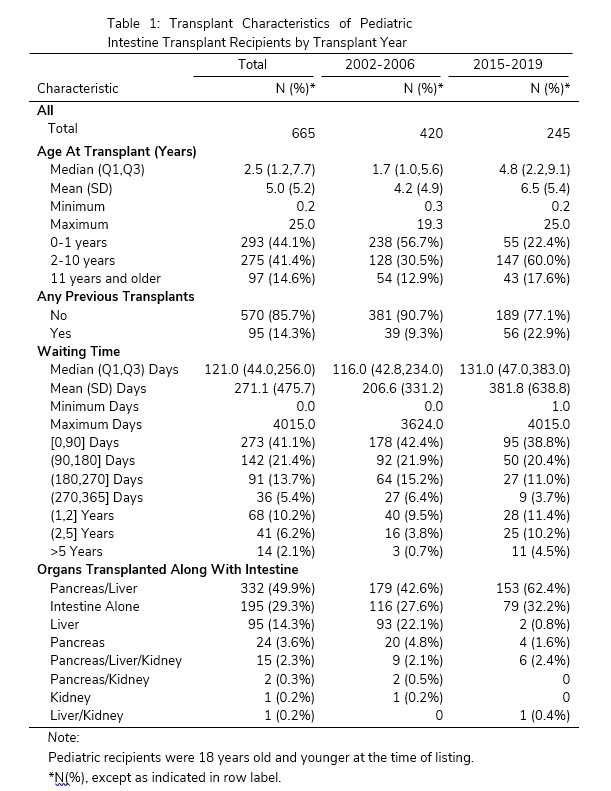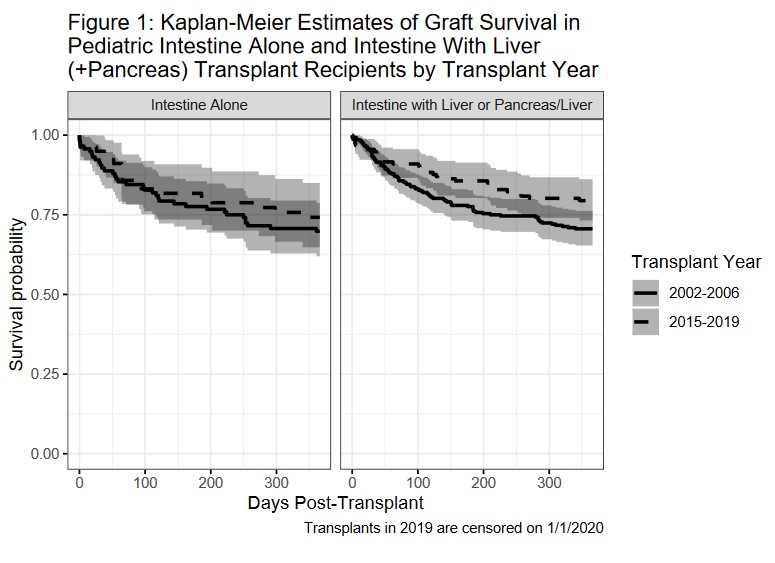A Comparison of Pediatric Intestine Transplant Between the Current Era (2015-2019) and the Peak Period (2002-2006)
1Seattle Children's Hospital, Seattle, WA, 2SRTR, Minneapolis, MN
Meeting: 2021 American Transplant Congress
Abstract number: 441
Keywords: Intestinal transplantation, Outcome, Pediatric, Waiting lists
Topic: Administrative » Quality Assurance Process Improvement & Regulatory Issues
Session Information
Session Name: Quality Assurance Process Improvement & Regulatory Issues
Session Type: Poster Video Chat
Date: Monday, June 7, 2021
Session Time: 7:30pm-8:30pm
 Presentation Time: 8:10pm-8:20pm
Presentation Time: 8:10pm-8:20pm
Location: Virtual
*Purpose: Demand for intestine transplants in children grew from its clinical inception in the late 1980s to a peak in 2007 of 111 small bowel-containing transplants. This was driven by improved posttransplant survival and high pretransplant mortality due to complications of life on total parenteral nutrition, mostly sepsis, loss of central venous access, and progressive liver disease. With the establishment of dedicated intestinal failure programs promoting coordinated medical, nutritional, and surgical care, the pretransplant mortality rates declined as did the referral and listing of infants and children for intestine transplant. This study aims to detail the differences between recipient cohorts in 2 5-year eras around the 2007 peak: January 2002-December 2006 and January 2015-December 2019.
*Methods: All intestine transplant recipients younger than 18 years at listing are included. For the 2 eras, we present summary statistics of recipient characteristics at transplant and Kaplan-Meier estimates of posttransplant survival.
*Results: The number of intestine-containing pediatric transplants fell from 420 in the first era to 245 in the second (Table 1). Median age at transplant increased from 2 to 5 years (mean, 4.2 vs 6.5); the most noticeable change being a reduction in recipients <2 years old, from 56.7% in the first era to 22.4% more recently, and a reciprocal increase in the 2- to 10-year age group (30.5% vs 60.0%). The fraction of retransplant (any previous transplant) more than doubled, from 9.3% in the first era to 22.9% in the second. Short bowel syndrome was the predominant cause of intestinal failure in both cohorts. Patients also waited longer from listing until transplant.
*Conclusions: Advances in intestinal failure management resulted in the need for fewer transplants at older ages, with no detriment in posttransplant survival.
To cite this abstract in AMA style:
Horslen S, Weaver T, Skeans M. A Comparison of Pediatric Intestine Transplant Between the Current Era (2015-2019) and the Peak Period (2002-2006) [abstract]. Am J Transplant. 2021; 21 (suppl 3). https://atcmeetingabstracts.com/abstract/a-comparison-of-pediatric-intestine-transplant-between-the-current-era-2015-2019-and-the-peak-period-2002-2006/. Accessed December 14, 2025.« Back to 2021 American Transplant Congress


